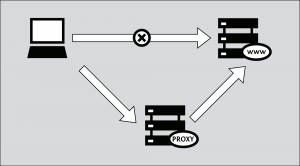Circumventing Internet Censorship
Circumventing Internet censorship is the process of using anti-censorship tools or software to bypass Internet censorship and filters. Certain countries like China and Iran have governments that enforce filters to censor what people can access on the Web, however, there are ways to get around these filters. Websites such as Circumventor.com and Peacefire.org are dedicated to distributing anti-censorship tools to users in these countries so they may roam the Internet freely.
Contents
Censorship
Many countries have filtering policies to block users from visiting certain sites used for gaming, entertainment, and social networking. The main reason for doing this is that they are trying to prevent dissidents from posting rebellious, threatening or undesirable material that is critical of those countries. Also, in the United States, public institutions such as schools and libraries are required to use filtering software to block access to certain existing public content such as obscene, pornographic and other materials related to the sexual exploitation of children.
Methods used by the government to censor the Web
Often times, governments will directly contact certain web sites requesting to censor Internet content. Within the first six months of 2012, Google received more than 1,000 requests from governments around the world to remove items such as YouTube videos and search listings.[1] Most of the time, Google will consent to a majority of those orders and request, however, certain countries such as China and Iran block content without notifying Google.
Circumvention technologies
Because of the growing global problem of censorship, citizens around the world are fighting to avoid government filters and exercise their first amendment rights to free speech and to access information of their own choosing. The tools, methods, and strategies that are used to by-pass Internet content filtering are referred to as circumvention technologies.How circumvention works
Users are blocked from connecting directly to the website, so they must connect through some third party site or machine outside of that country that fetches the content and sends it back.[2] It is relatively simple to disable most blocking programs and there are numerous ways to beat a smart filter under a variety of circumstances and by a wide range of users. Usually it takes only four or five steps depending on how the user is accessing the Internet. This is either done through software that is installed on the users computer or the user can manually go through a third party proxy server, to avoid having to use the server on which your smart filter operates. Most proxy sites will allow users to enter their email so they can receive new proxy sites if and when the site gets blocked. Although there are many ways to get access to a blocked site, it is important to find a secure method and to fully understand the technology used for circumvention.
Other tools to defeat censorship
- Cached pages
- Translation services
- RSS Aggregators
- Alternate Domain Names
- Web Accelerator
- Virtual Private Networks
- Proxies
Developers of circumvention software
Ethical Issues
Issues with children
The use of censorship techniques oftentimes are deployed against the users will in order to protect their welfare and safety. In the Information age, children have access to an unlimited amount of data, and most Americans have agreed that exposure to sexual imagery will do irreparable harm to their children; therefore censorship is appropriate for them. Opponents of censorship such as Bennett Haselton, creator of Circumventor.com and Peacefire.org want to create awareness and report imperfections with regards to Internet blocking programs. Haselton believes the Internet is not dangerous to children and it is unfair to deprive them because of their youth. Despite the criticism of circumvention, there has been little evidence that children are harmed from unfiltered graphic material and the Internet should not be seen as a detrimental tool. It is important for children to have access to new information so they will be able to thrive culturally and succeed educationally and economically.[3]
Issues with countries that censor
Trying to access content that is highly critical and is considered a security threat to the country can be a dangerous practice and a serious violation of the law. High profile human rights organizations and groups may be on the government’s watch list and constantly monitored. Internet users need to take extreme cause by choosing circumvention technologies that offer anonymity and security because the government may seize the computer at any time and may even have precedent for arrests for the practice of circumventing Internet censorship.[4]
Misconceptions
According to the First Amendment in the U.S. Constitution, congress shall make no law prohibit free speech.[5] However, there are certain cases where the first amendment does not protect. Laws exist regarding libel, obscenity, national security, access to government information, and regulation of electronic mass communications.[6]
Battle between the censors and the circumventors
See Also
References
- ↑ http://news.cnet.com/8301-1023_3-57454920-93/google-sees-alarming-level-of-government-censorship/
- ↑ http://www.igniteseattle.com/2011/12/bennett-haselton-circumventing-internet-censorship-around-the-world/
- ↑ http://www.freedomforum.org/templates/document.asp?documentID=11141
- ↑ http://www.masternewmedia.org/privacy_security/bypass-internet-censorship/bypass-internet-filters-anonymous-browsing-guide-20071118.htm
- ↑ http://www.law.cornell.edu/constitution/first_amendment
- ↑ http://courses.cs.vt.edu/cs3604/lib/Censorship/notes.html
http://www.flossmanuals.net/bypassing-censorship/
